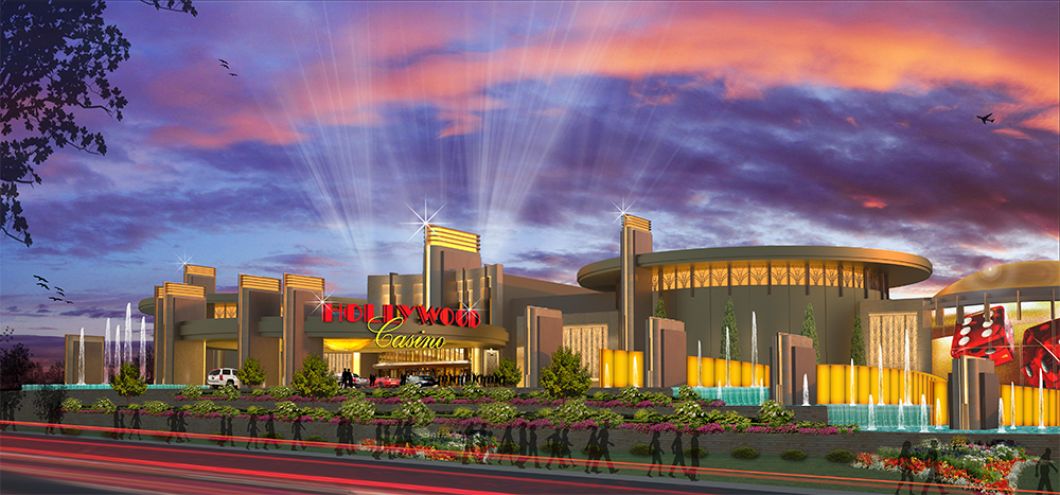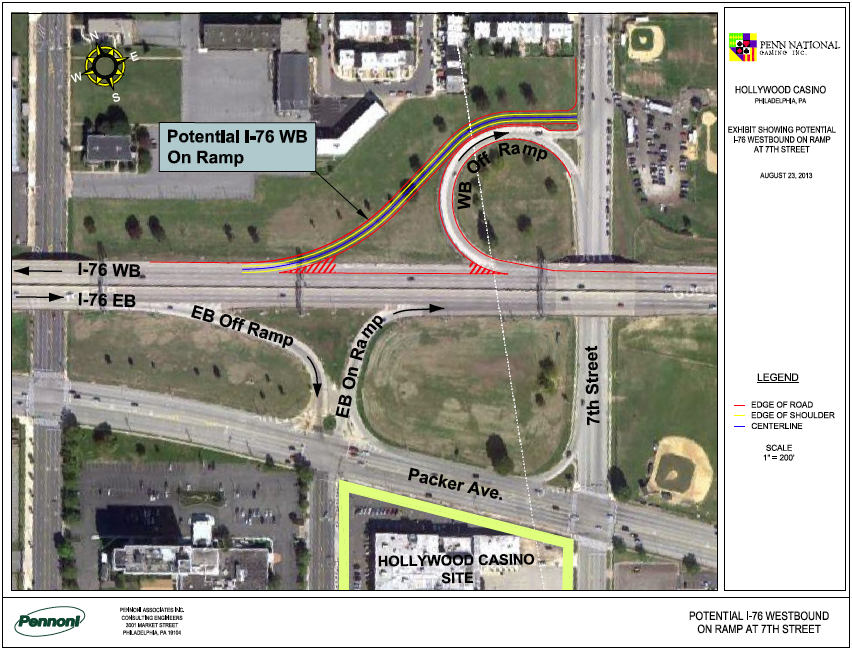Penn National: We’d bring the Hollywood experience, improvements to the best location, and creative philanthropy

Penn National Gaming should get Philadelphia’s remaining casino license, a spokeswoman said, because its established Hollywood brand would attract many customers, a promised improvement to I-76 would make its Stadium District location even better, and its charity ownership model would funnel money to Philadelphia schools and pensions.
Two of those reasons – experience and location – were also given when PlanPhilly asked the “why you?” question to Penn National’s across-the-street competition, Live! Hotel & Casino. The team behind the third stadium-area proposal, Casino Revolution, also claims its location is best.
When asked in a recent interview why the experience points should go to Penn National and its Hollywood Casino proposal rather than the neighbors across the street, Vice President for Public Affairs Karen Bailey said the Live team has experience, just not as much as Penn National.
“One gentlemen owns and operates one casino right now. He’s built others, doesn’t operate them,” she said. “The other partner, obviously has experience elsewhere in the country, but not the vast experience we do. We have 26 facilities around the country and Canada.”
Bailey noted that Penn National, which is based in Wyomissing, PA, opened three new casinos in 2012 alone, and a total of five since 2008. This was done “while the economy was in a downturn, while the industry was in a downturn,” she noted. “We obviously had the fiscal prudence and ability to continue growing through that time period.”
Like the other two stadium-area proposals, Penn National touts its location for being adjacent to both existing facilities that draw millions of visitors per year, and major highways that make access for driving customers easier than at the two Center City options, The Provence at Broad and Callowhill and Market8 and 8th and Market.
But, Bailey says, Penn National is the only applicant that has committed to making that highway access better. “We committed to building direct, west-bound access onto I-76, so that our customers aren’t traveling on Packer down to Broad to access I-76 down there,” she said. “That was a key concern with the neighborhood groups in that area, and something we took very seriously. We included that cost in our development costs. Others have said they’ll look at it, they’ll consider it, they’ll study it. We’ve said we’ll build it.”
Penn National would build the $480 million Hollywood Casino in two phases. It would open between 18 and 24 months after the start of construction with 2,050 slot machines, 66 table games and a 15-table poker room. Amenities would include a sports pub, casual grill, four-outlet food court, noodle bar and 180-seat entertainment lounge. Phase I would also include a 3,500-car garage, the biggest garage of any proposal.
Phase II would include a 500-room hotel, 1,000 more slots, 40 more table games, 5 more poker games and more food, beverage and parking options. Bailey notes that the economic projections Penn National gave the state are based on Phase I only.
Critics have noted that the Hollywood proposal is the smallest in scope and investment, Bailey said. “We believe we are the right size for the market,” she said. “We know the market. We have a facility up the road in Harrisburg. We brought to the gaming commission, to the community, what we know will work, and what we can produce for the state and city.”
Bailey said that Penn National builds what it says it will build, on time and on budget, and would rather under-promise than over-promise.
Local Penn National representative David Dunphy accompanied Bailey on the interview and put a finer point on this statement. He said any comparison between Hollywood and Live! Hotel and Casino should note differences between Cordish’s proposal for the nearby XFINITY Live! and what was built. Cordish plans an expansion, some of which would depend on whether they and Greenwood get the casino license.
A Philadelphia Hollywood Casino would share some key characteristics with other Hollywoods across the country, but would definitely have Philadelphia flavor, Bailey said.
Like all Hollywoods, the one proposed for South Philadelphia would be done up in Art Deco style and harken to the Hollywood, California’s film industry Golden Age. At each gaming table, stylized trees would hold electronic monitors in their branches, broadcasting sporting events on the weekends.
“On opening day, guests can dine at our Final Cut steakhouse, which has been winning awards all over the country,” Bailey said. Wine Spectator recently gave its wine list an award. Final Cut, the food court, sports bars and Asian dining options “are all products that we’ve tried and tested across multiple regions across the country,” she said. “But we will tailor them to what our customer base is.”
Final Cut chefs will use local ingredients and flavors on the menu, for example, she said. The city’s film history – and present – goes well beyond Rocky, Dunphy said, and the Hollywood theme brings with it an opportunity to highlight Philadelphia cinema.
The familiar amenities mean fans of Hollywood Casino’s elsewhere will recognize what they like in Philadelphia, Bailey said. And Penn National would promote its new casino – and the city surrounding it – to the millions of people in its data base.
Those who’ve earned Hollywoods loyalty rewards elsewhere in the country could use them in Philadelphia, she said. And she anticipates that, as the company does at its other locations, Hollywood will partner with local businesses outside the casino, so that loyalty rewards can be used there as well.
“We have players in multiple jurisdictions around the country earning points on our system,” Bailey said. “People earning them around the country can come to Philadelphia and use their points. Or, they can play at Hollywood (here) and can earn points to visit in Las Vegas.
“We’ve got over 4 million people in our data base. Over 2 million of them live within a short flight or drive here to Philadelphia.”
Bailey said what sets the Hollywood proposal further apart from its competition is a plan to share its profits.
Because Penn National already operates a Pennsylvania casino, it could have no more than a one-third ownership stake in a new one. (This is the reason Greenwood Gaming, which owns Parx, partnered with Cordish on the Live! Hotel and Casino proposal.)
Penn National noticed in other jurisdictions where it has bid for casinos that decision-makers always want to know who offers the most benefit to the community in which they will operate. So to meet the ownership rules and up the benefit, Penn National decided to create a charity as a two-thirds partner.
All casinos give money to organizations in their communities, but Bailey said Penn National has “guaranteed a minimum of $2 million per year until our debt service has been paid off for construction. Then it jumps up to at least $15 million per year” for city schools and city pension funds.
(When asked if Penn National had secured loans to build, Bailey said, “We don’t need them.” She said, “We have the ability to pay cash for development if we so chose to. Or we can use a credit revolver, or we can get outside financing.”)
The board of the proposed non-profit, the Philadelphia Casino Benefit Corporation (PCBC), would be chaired by Joe Domenico, a gaming executive with experience around the country. The board would consist of other leading business people and philanthropists from the Philadelphia area.
Penn National made a similar proposal when it unsuccessfully bid on a license in Maryland.
While Penn National says Hollywood’s location is best, and the two other South Philadelphia proposals agree that the stadium-area beats Center City, a city economic analysis does not agree.
When presenting that analysis to the state gaming board last fall, Deputy Mayor Alan Greenberger noted traffic concerns of neighbors – something Bailey said the I-76 ramp improvement addresses.
Greenberger said the city also believes “choosing the proposal that will generate the largest overall economic benefit to Philadelphia over the long-term” makes the most sense, and the analysis shows that’s not Hollywood. “We project that this proposal will generate the lowest number of direct and indirect jobs once the casino is constructed, the lowest amount of total gaming and non-gaming revenue, and the lowest tax revenue to both the City of Philadelphia and the Commonwealth of Pennsylvania.”
In the recent interview, Bailey said, “We thought it interesting that there was such a differential in revenues between us and our neighbor across the street.” Penn National doesn’t agree with the city’s numbers, but it didn’t formally respond to them. “We actually just stand by our numbers,” she said. “We’re confident in what we project, in what we create, in what we put forward.”
Penn National and the other five applicants will have one last shot to convince the Pennsylvania Gaming Control Board they are the right choice for the license at suitability hearings next week. The board is expected to make a decision sometime in the first part of 2014.
To learn more about the Hollywood and other casino proposals, see documents submitted to the gaming board at the PGCB website, here.

WHYY is your source for fact-based, in-depth journalism and information. As a nonprofit organization, we rely on financial support from readers like you. Please give today.



